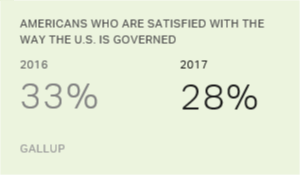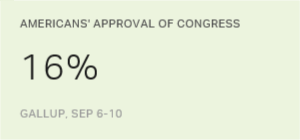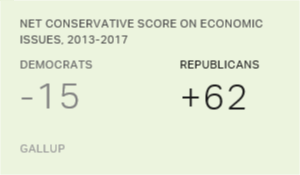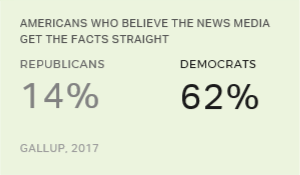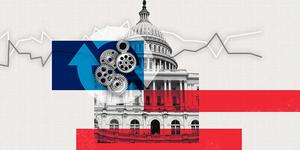Story Highlights
- 28% are satisfied with the nation's governance, down from 33% last year
- Satisfaction was at its high point, 59%, in 2002
- Satisfaction with governance is related to Congress approval
This story is part of a series focusing on Americans' confidence in various types of government, views of the political parties and of the role and power of government. Follow the series on the government topic page.
WASHINGTON, D.C. -- President Donald Trump vowed to "drain the swamp" in Washington if elected president, but so far, Americans' dissatisfaction with the way the nation is being governed shows no signs of easing. Twenty-eight percent are satisfied and 71% are dissatisfied, slightly more negative than last September when 33% were satisfied and 67% dissatisfied.
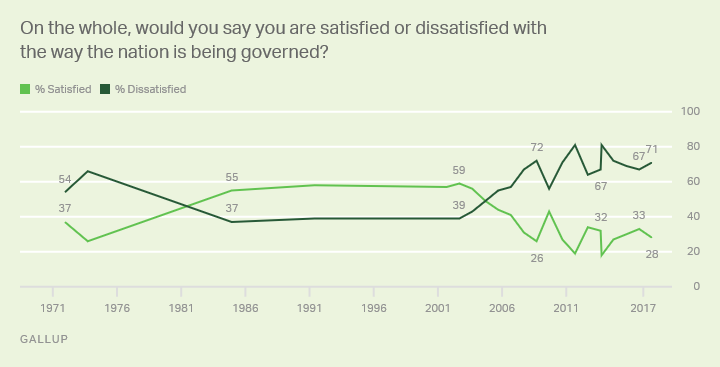
Gallup has updated this measure annually since 2001, and four times before that between 1971 and 1991.
At times, a majority of Americans were satisfied with the nation's governance:
- in 1984 just after Ronald Reagan was swept back into office for his second term
- in 1991, a few months after the successful Persian Gulf War
- in 2001, just before the 9/11 terrorist attacks
- in 2002 and 2003
The all-time high on this satisfaction measure was 59% in September 2002.
Since 2004, however, satisfaction with the way the nation is governed has consistently been below 50%. The low points came in 2011 (19%) after the U.S. credit rating was downgraded in response to a deal to raise the federal debt limit, and in October 2013 (18%) during that month's federal government shutdown.
The current level of 28% satisfaction is up modestly from these lows, but is down from last year's 33% and continues the pattern of negativity seen for over a decade.
Satisfaction With Governance Shifts When Party of President Changes
Americans' views of the nation's governance are closely related to the occupant of the White House, as would be expected.
Republicans were more positive than Democrats about governance during the George W. Bush years, and Democrats were more satisfied than Republicans when Barack Obama was in the White House. Now, with a Republican president again in charge, Republicans' satisfaction level has jumped, while Democrats' has dropped. Democrats' low satisfaction level is essentially tied for the lowest on record since 2001.

Despite these underlying shifts, overall satisfaction with the nation's governance has remained low across the second half of the Bush administration and in the years since. This reflects the finding that Republicans' satisfaction -- although currently higher than Democrats' -- is no higher than it was in Bush's last year in office, and is well below the years before 2007.
Notably, almost half of those who approve of Trump's performance as president still say they are dissatisfied with the way the nation is being governed. Republicans are likely taking into account their low opinions of Congress when they assess the way the nation is being governed, even though their party controls the presidency.

Gallup Analytics
Subscribe to our online platform and access nearly a century of primary data.
Governance Satisfaction Related to Other Political and Economic Measures
The trends in Americans' satisfaction with national government generally parallel changes in the public's assessment of congressional job approval and presidential job approval; this is not the case for economic confidence.
Americans' assessments of the job Congress is doing is significantly related to changes in their views of how the nation is being governed, as would be expected. As views of Congress have gone up or (mostly) down, so have views of the way the nation is being governed. Throughout, job ratings for Congress have been lower than the measure of satisfaction with the way the nation is being governed.
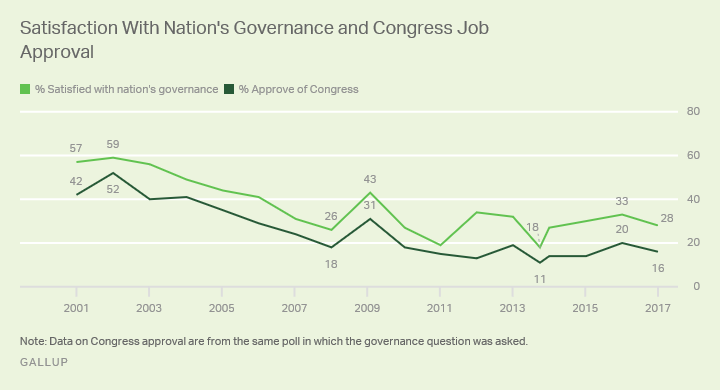
From 2003 through 2006, Americans' satisfaction with national governance essentially matched presidential job approval. In 2007, however, the gap began to expand and remained somewhat wider during the Obama administration and now in the first year of the Trump administration. Throughout this latter period, more Americans have approved of the president's job performance than felt satisfied with the way the nation is being governed, even as both measures moved up and down in rough parallel. Trump's job approval rating in the current survey is down from Obama's last September, and the governance measure has dropped in similar fashion -- although the Trump measure remains significantly higher.
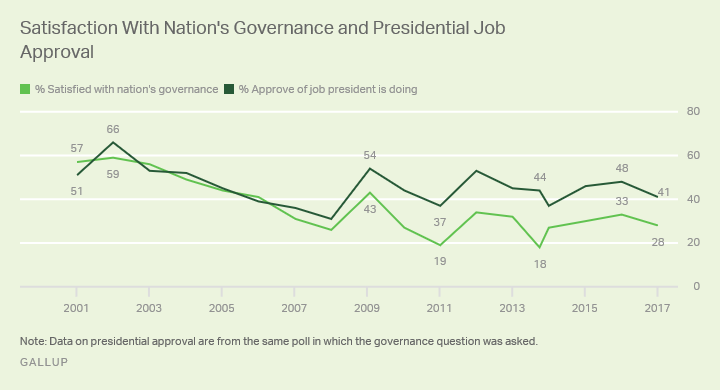
At the same time, in contrast to satisfaction with the nation's governance, confidence in the U.S. economy has edged upward in recent years -- underscoring that Americans' views of the way the nation is being governed reflect more than just a reaction to economic conditions.
Bottom Line
Rather than restoring Americans' confidence in Washington, the new presidential administration has been associated with a slight decline in Americans' satisfaction with the way the nation is being governed. This low level of satisfaction with the nation's governance is also reflected in Gallup's "most important problem" assessment, which shows that complaints about government this year have frequently been near the top of the list of the most important problems facing the nation.
Americans' low level of confidence in the government is not a simple reflection of their views of the presidency. While both Trump's job approval and the governance measure are down slightly from last year, Trump's job performance remains considerably higher than Americans' satisfaction with the nation's governance. On the other hand, Americans' approval of the job Congress is doing has consistently been lower than their satisfaction with governance overall, including in the current survey. Americans may, in short, be taking both the president and Congress into account when asked to assess how the nation is being governed, in essence splitting the difference in their assessments of these two branches of government.
Because both presidential and congressional job approval ratings are low on a historical basis, it is not surprising that the broad measure of confidence in how the nation is being governed is low as well. These perceptions are all clearly yoked to one another, and it's likely to require significant upward movement on the two approval ratings before satisfaction with the way the nation is being governed gains significant ground going forward.
Survey Methods
Results for this Gallup poll are based on telephone interviews conducted Sept. 6-10, 2017, with a random sample of 1,022 adults, aged 18 and older, living in all 50 U.S. states and the District of Columbia. For results based on the total sample of national adults, the margin of sampling error is ±4 percentage points at the 95% confidence level. All reported margins of sampling error include computed design effects for weighting.
Each sample of national adults includes a minimum quota of 70% cellphone respondents and 30% landline respondents, with additional minimum quotas by time zone within region. Landline and cellular telephone numbers are selected using random-digit-dial methods.
View survey methodology, complete question responses and trends.
Learn more about how the Gallup Poll Social Series works.
